Papers by Gommert Van Koeveringe
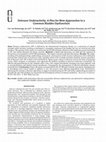
Neurourology and Urodynamics, Jun 1, 2011
Aims: Detrusor underactivity (DU) is defined by the International Continence Society as a contrac... more Aims: Detrusor underactivity (DU) is defined by the International Continence Society as a contraction of reduced strength and/or duration resulting in prolonged or incomplete emptying of the bladder but has yet received only little attention. The purpose of this report is to summarize the ICI-RS meeting in Bristol in 2010 exploring current knowledge on DU and outline directions for future research. Methods: A think tank discussion was held and the summary of discussions was presented to all ICI-RS participants. This report is based on the final discussions. Results: The understanding of the pathophysiology, epidemiology, assessment, and treatment of DU remains rudimentary. DU is defined by pressure-flow analysis but no consensus exists regarding which of the available formulae should be used for quantification of detrusor work. DU is likely to be multifactorial. Aging causes a decay in detrusor activity but other concomitant causes, either myogenic or neurogenic, may aggravate the problem resulting in decrease of detrusor contractility. No effective pharmacotherapy for the condition exists. Only a few surgical therapeutic strategies have been explored, such as neuromodulation and skeletal muscle myoplasties. Consequently, the management of affected individuals remains unsatisfactory. Conclusions: Future directions recommended by the ICI-RS panel include assessment of pathogenesis by developing novel animal models in addition to new non-invasive tests allowing longitudinal trials. Furthermore, optimizing the existing evaluation algorithms to support standard testing for DU and further epidemiological studies to quantify the size of the problem are required for the development of future treatment modalities. Neurourol. Urodynam.

ics.org, Sep 3, 2019
Evidence proves the bladder to contain microbiomes which under standard conditions are not percei... more Evidence proves the bladder to contain microbiomes which under standard conditions are not perceivable. Whether they stand to bene t us or have pathogenic roots is dependent upon the singular microbiome characteristic. In regard to the uncovering of the relationship between microbiome and the lower urinary tract symptom, there has been a gargantuan amount of research in recent years. All urine samples are collected using a transurethral catheter in order to elude the urine from bacterial contamination from the external tissues and in order to determine the resident microbial, the bacterial 16S rRNA is amplified through PCR and the NGS sequencing is performed through illumina MiSeq. In all the studies concentrating on the relation among microbiome and OAB, the demonstration was made that Lactobacillus in patients suffering from OAB had increased in comparison to the subjects without the condition. However; in only one study a decrease in Lactobacillus was observed with an increase of Gardnerella spp.. In another study in patients suffering from OAB, an increase in Streptococcus compared to healthy subjects was observed. In the case of BPS/IC patients, it was evident that these patients had an increase in Lactobacilli. So far, there is still no evidence provided of a relation between the urinary tract microbiome and Detrusor Overactivity. As regards to the CP/CPPS , in one study Burkholderia cenocepacia was detected. In a separate study, a increase in the Enterococcus levels was witnessed where as the Escherichia coli were decreased. In a third study, it was seen that the Clostridiae and Bacteroidetes were increased.
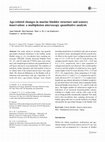
Age, Jan 29, 2016
Our study aimed to examine and quantify age-related structural alterations in the healthy mouse b... more Our study aimed to examine and quantify age-related structural alterations in the healthy mouse bladder using ex vivo two-photon laser scanning microscopy (TPLSM). Freshly dissected bladders from 25-, 52-, and 85-week-old C57bl/6J mice were examined, and morphological analyses and quantification of cell layers and nerves were performed. The numbers of stretched, curled, branched, and total number of nerves in volume units of the stained muscle layer were quantified. We observed differences in the bladder wall architecture and innervation with age. Especially in 85week-old mice, age-related changes were found, including detachment of urothelial cells and an increase in connective tissue, intermingled with the smooth muscle fibers in the muscle layer (collagen-smooth muscle ratio of 1.15 ± 0.29). In 25-and 52-week-old mice, the collagen-smooth muscle ratios were 0.20 ± 0.04 and 0.31 ± 0.11, respectively, and a clear separation of collagen and muscle was observed. The overall number of nerves and the number of curled nerves were significantly higher in the 85-week-old mice (74.0 ± 13.0 and 25.9 ± 4.8, respectively), when comparing to 25-weekold mice (26.0 ± 2.7 and 6.7 ± 1.2, respectively) and 52week-old mice (43.8 ± 4.3 and 22.1 ± 3.3, respectively). Significant age-related alterations in bladder morphology and innervation were found, when comparing freshly dissected bladder tissue from 25-, 52-, and 85-week-old mice. The higher number of curled nerves might be an indication of an increased neurotransmitter release, resulting in a higher nerve activity, with a part of the nerves being possibly mechanically impaired. This study shows that two-photon laser scanning microscopy of healthy aging male mice is a useful method to investigate and quantify the age-related changes in the bladder wall.
Journal of Clinical Medicine, Mar 29, 2023
This article is an open access article distributed under the terms and conditions of the Creative... more This article is an open access article distributed under the terms and conditions of the Creative Commons Attribution (CC BY
Neurourology and Urodynamics

Neurourology and Urodynamics
AimThe aim of this study is to evaluate safety and efficacy of ASP8302, a novel positive alloster... more AimThe aim of this study is to evaluate safety and efficacy of ASP8302, a novel positive allosteric modulator for the muscarinic M3 receptor (M3‐PAM), in patients with underactive bladder (UAB).MethodsA randomized, double‐blind, placebo‐controlled multicenter study was performed in adult male/female subjects with UAB, defined as incomplete bladder emptying (postvoid residual volume [PVR] > 100 ml) without significant bladder outlet obstruction and/or overactive bladder. Subjects were randomized (1:1) to receive 4‐week oral once‐daily administration of 100 mg ASP8302 or matching placebo. Primary endpoint was a change from baseline in PVR measured by catheterization after standardized bladder filling (PVRC2). Other endpoints included PVR and bladder voiding efficiency (BVE) measured in various ways, uroflowmetry, bladder diary, and questionnaires. Pressure‐flow studies were performed in a subgroup.ResultsOne hundred and thirty‐five patients were randomized (ASP8302 group: 65 patien...
Neurourology and Urodynamics, 2017
Uren A1, Cotterill N1, Lasch K2, Deshpande C2, King-Kallimanis B2, van Koeveringe G3, Harding C4,... more Uren A1, Cotterill N1, Lasch K2, Deshpande C2, King-Kallimanis B2, van Koeveringe G3, Harding C4, Oelke M5, Chapple C6, Hillary C6, Belal M7, Bosch R8, Blok B9, Klaver M10, Bongaerts D10, Hakimi Z10, Abrams P1 1. Bristol Urological Institute, Bristol, UK, 2. Pharmerit, Boston, United States, 3. Maastricht University Medical Centre, Maastricht, The Netherlands, 4. Freeman Hospital, Newcastle-upon-Tyne, 5. Hannover Medical School, Hannover, Germany, 6. Royal Hallamshire Hospital, Sheffield, 7. Queen Elizabeth Hospital, Birmingham, UK, 8. University Medical Centre Utrecht, Utrecht, The Netherlands, 9. Erasmus Medical Centre, Rotterdam, The Netherlands, 10. Astellas Pharma B.V., Leiden, The Netherlands
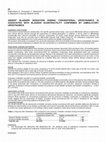
Neurourology and Urodynamics, 2014
Hypothesis / aims of study In the quest to unravel detrusor underactivity, one specific question ... more Hypothesis / aims of study In the quest to unravel detrusor underactivity, one specific question keeps rising – how can we differentiate detrusor underactivity from normal detrusor function through the assessment of voiding parameters? In addition, it will be useful to differentiate acontractility from reduced contractility in detrusor underactivity. An earlier study already showed differences between the urodynamic tools that are currently used to differentiate between both entities. Moreover, the ambulatory urodynamic study (ambulatory-UDS) appeared to be a more precise tool to define true bladder acontractility [1]. The purpose of this study is to evaluate if we can predict ambulatory-UDS derived bladder acontractility by using bladder sensation during conventional urodynamics in patients who are acontractile on a conventional urodynamic study (conventional-UDS).
Neurourology and Urodynamics, 2018
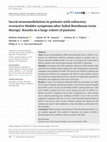
Neurourology and Urodynamics, 2021
AimsSacral neuromodulation (SNM) and Botulinum toxin A (BoNT‐A) injections are well‐known third‐l... more AimsSacral neuromodulation (SNM) and Botulinum toxin A (BoNT‐A) injections are well‐known third‐line treatment options in patients with refractory overactive bladder (OAB). Our aim is to evaluate the success rate of SNM in patients who received prior therapy with BoNT‐A injections.MethodsAll patients with OAB symptoms referred for SNM between 2006 and 2019 were included. History taking and 3‐day voiding diaries assessed the complaints and suitability for SNM. The success rate of SNM in patients who received prior BoNT‐A was compared with BoNT‐A naive patients. Success was defined as an improvement of 50% or greater in voiding diary parameters. Satisfaction was registered at their most recent visit.ResultsA total of 263 patients underwent SNM test stimulation, of which 75 (16 male/57 female) received prior BoNT‐A and 188 (46 male/142 female) were BoNT‐A naive. Success rate for SNM in BoNT‐A naive patients was 72.9% and in BoNT‐A patients 66.7% (p = 0.316). Success rate after ≤2 BoNT‐...
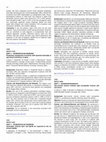
Journal of the Neurological Sciences, 2017
median and ulnar compound muscle action potential amplitudes than tibial and peroneal ones. Elect... more median and ulnar compound muscle action potential amplitudes than tibial and peroneal ones. Electromyography (EMG) showed 40% of patients have EMG abnormalities in asymptomatic limbs. Neurophysiological evidence of "split hand" was frequent in upper limb phenotype. Sensory studies were abnormal in 16.3 %. Most patients were classified in mRS 1 and 2 (73.9%) at the time of diagnosis which was statistically significant among subgroups. Bulbar and distal upper limb subtypes had a better prognosis. 5.4% of patients used mechanical ventilator; all in bulbar subgroup. Conclusion: In our ALS patients, upper limb onset was the most common. Time of presentation varied among phenotypes. Extensive EDx can contribute to early diagnosis in asymptomatic limb and improve diagnostic certainty. Abnormal sensory study was also common. EDx data clearly correlates with clinical phenomena and prognosis. At the time of diagnosis, ALSFRS was in moderate range and most patients had moderate disability.
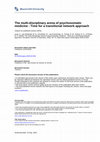
The European Journal of Psychiatry, 2020
People interested in the research are advised to contact the author for the final version of the ... more People interested in the research are advised to contact the author for the final version of the publication, or visit the DOI to the publisher's website. • The final author version and the galley proof are versions of the publication after peer review. • The final published version features the final layout of the paper including the volume, issue and page numbers. Link to publication General rights Copyright and moral rights for the publications made accessible in the public portal are retained by the authors and/or other copyright owners and it is a condition of accessing publications that users recognise and abide by the legal requirements associated with these rights. • Users may download and print one copy of any publication from the public portal for the purpose of private study or research. • You may not further distribute the material or use it for any profit-making activity or commercial gain • You may freely distribute the URL identifying the publication in the public portal. If the publication is distributed under the terms of Article 25fa of the Dutch Copyright Act, indicated by the "Taverne" license above, please follow below link for the End User Agreement:
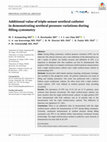
Neurourology and Urodynamics, 2019
During filling cystometry, urethral pressure variations (UPV) can be observed. The clinical relev... more During filling cystometry, urethral pressure variations (UPV) can be observed. The clinical relevance and a clear definition of this phenomenon are still a matter of debate. For further research and definition of UPV, it is important to determine how this condition can best be demonstrated. The purpose of this study is to compare continuous urethral pressure measurements with a single urethral-sensor catheter and a triple urethral-sensor catheter in demonstrating UPV. Methods: Seventy-five adult female patients requiring urodynamic investigation enrolled in this prospective study. All patients underwent two series of filling and voiding cystometry. One series was performed with a dual-air balloon sensor urodynamic catheter, the other series with a triple urethralsensor catheter. UPV were defined as urethral pressure drop exceeding 30 cmH2O. Results: The prevalence of UPV was 37.3% (28 out of 75 patients), more common than detrusor overactivity. The triple urethral-sensor catheter was more sensitive than the single urethral-sensor catheter: In eight patients UPV were demonstrated with both catheters and in 18 patients only in the measurement with the triple urethral-sensor catheter. This difference in detection was significant (P < .001). Conclusion: There is an additional value in measurement with the triple urethral-sensor catheter for demonstration of UPV during filling cystometry. Currently, continuous measurement of urethral pressure during filling cystometry and UPV is not defined within International Continence Society terminology. The single urethral-sensor catheter is useful for a start, however, it demonstrates less than half of all UPV K E Y W O R D S LUTS, urethral disease/analysis, urethral pressure, urodynamics How to cite this article: Kummeling MT, Bovelander E, van Uhm JI, et al. Additional value of triple-sensor urethral catheter in demonstrating urethral pressure variations during filling cystometry.
Neurourology and Urodynamics, 2019
European Urology Supplements, 2019
Does sacral neuromodulation have an effect on bladder sensations in patients with nonobstructive ... more Does sacral neuromodulation have an effect on bladder sensations in patients with nonobstructive retention?








Uploads
Papers by Gommert Van Koeveringe